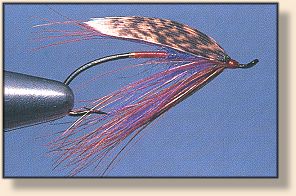Summer Twilight II
By H. Kent Helvie
The wet steelhead fly makes up a large, diversified and important group of
dressings. The term wet fly a catch all phrase for those flies that do not qualify
as a dry. Spey or prawn, etc. Some of these flies are traditional patterns but
many are far from traditional, basic or standard yet they all fall into the same
class by a freak chance of fate.
Many of these flies can challenge and test a tier's skill and patience. Their
intricate design and unusual use of materials help make them unique. Others are
what many professional fishermen call guide flies, flies that are very effective on
the fish and are quick and inexpensive to tie because clients often lose a lot of flies.
Big, lead eyes leech patterns are good examples of guide flies but they can be nearly
fatal if they hit you in the head.
Graceful low water flies also fall into this group. Many low water patterns are
trimmed-down standard flies yet other are sleek flies specially designed for this
type of fishing. Quite often these flies are Atlantic salmon flies which we
steelheaders have adapted to our needs. Although they have their own
characteristics, these flies are still wet flies. It is hard to put low water flies
in their own group because low water is generally a manner in which a fly
is dressed rather than a pattern in itself.
Materials: Summer Twilight II
Hook: Low water or Bartleet style hook, I prefer Alec Jackson Spey Hook.
Tag: Fine oval gold tinsel.
Thread: Red floss.
Body: Rear third red floss; balance dubbed purple seal or substitute.
Collar: Long, deep purple hackle followed by a dyed red golden pheasant rump feather.
Wing: Mottled turkey quill.
Tying Steps:

1. Start with the thread attached in the center and tie in a piece of fine oval tinsel
and tie it down to the start of the tag, above the point of the hook.

2. Wind four or five turns of tinsel for the tag and tie off and then tie in a
thin strand of red floss.
|












